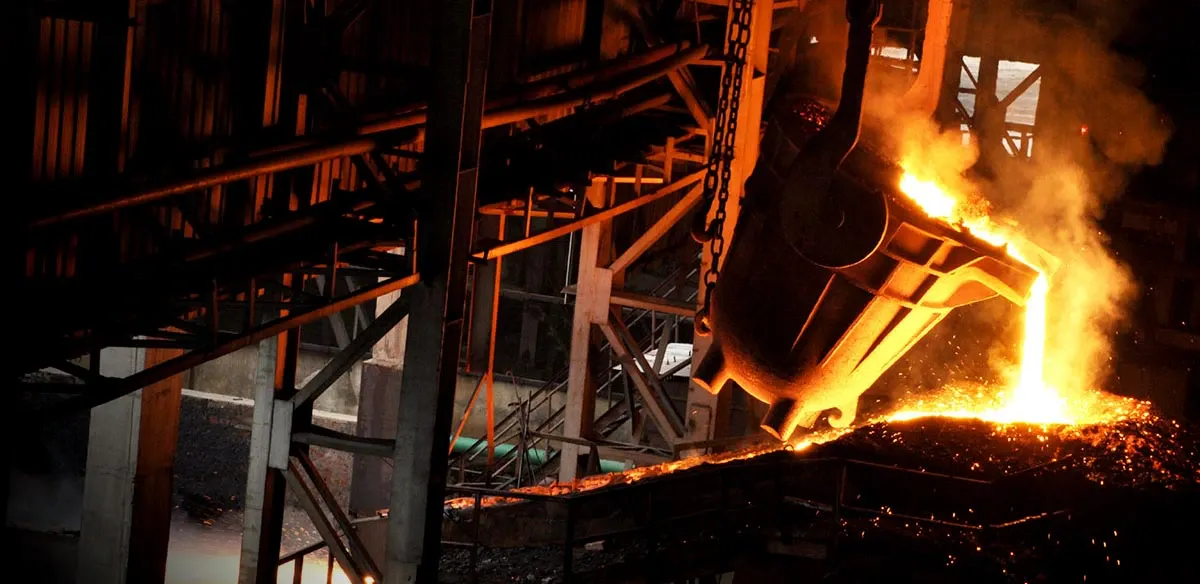Discover the intricate process and applications of FeCr (ferro chrome) production, vital for stainless steel and alloy manufacturing.
Ferro chrome
FeCr is an alloy of chromium and iron containing between 45% and 70% of chromium. It also contains varying amounts of iron, carbon and other alloying elements. FeCr with chrome content below 56% is known as ‘charge chrome’. FeCr is the major alloying element in the production of stainless steel. The use of FeCr depends widely on the carbon content.
FeCr can therefore be classified as
(i) high carbon FeCr (FeCrHC) with 4% to 12% C,
(ii) medium carbon FeCr (FeCrMC) with 0.5% to 4% C, and
(iii) low carbon FeCr (FeCrLC) with 0.1% to 0.5% C.
FeCrHC, produced from higher-grade ore, is normally used in specialist applications such as engineering steels where a high Cr to Fe ratio and minimum levels of other elements such as sulphur, phosphorus and titanium are important. FeCrLC is used during steel production to correct chrome percentages, without causing undesirable variations in the carbon or trace element percentages. It is also a low-cost alternative to metallic chrome for use in super alloys and other special melting applications.
The main raw material to produce FeCr is chromite ore, which is a mineral that contains iron and chromium oxides. The ratio between Cr and Fe in the chromite ore determines the chromium content of the alloy produced, e.g. a high Cr to Fe ratio is advantageous for the production of a ferroalloy with high chromium content. Chromite ores are used in the form of hard or upgraded lumps, friable lumps, or fine concentrate.
The reducibility of different ores is quite different. Generally speaking for the production of FeCr, podiform ores are of higher quality resulting in high FeCr alloy, while stratiform ores have lower chromite content and a low Cr to Fe ratio resulting in charge chrome alloy. Podiform ores most often give a chromium recovery in excess of 90%, while fine stratiform ores have below 70% recovery in conventional type production routes. With the DC plasma process, recovery is reportedly above 90%. This compensates for the higher consumption of electrical energy needed to increase the process temperature to achieve faster reduction.
To convert ore fines and concentrates to a material that can be used in the furnace, they first need to be agglomerated by briquetting, pelletizing/sintering or sintering alone. Agglomeration is necessary to achieve good recoveries and also to give a permeable burden, which allows the gas from the reaction zone to escape. In this widely used technology of sintered pellets (grinding, pelletizing and sintering) the increased reduction rate of the fine stratiform ores is based on increased reaction surface, the recovery with pellets being close to 87%. For podiform ores, the recovery benefits of these alternative process routes are not of the same magnitude.
Depending on the different production routes and the desired carbon content of the FeCr, carbon or silicon is used as a reducing agent. For the production of FeCrHC, carbon is added to the process as a reducing agent in the form of metallurgical coke, coal or charcoal. Metallurgical coke is the most common reducing agent. It is important that coke with low phosphorus and sulphur contents is used because 60% to 90% of the phosphorus and 15% to 35% of the sulphur is transferred into the ferroalloy. For the production of FeCrLC, ferro-silico-chromium and ferro-silicon are used as reducing agents in a silico-thermic reduction. In the case of coal, washed coal is preferred to have improved reducibility.
For some processes, primary raw material like coke or secondary raw materials needs to be dried before using them in the process. Coke drying is important to remove moisture.
To achieve the right ferroalloy analysis, good metal recovery and a satisfactory furnace operation, auxiliary materials such as quartzite, bauxite, corundum, lime and olivine can be added to the burden as fluxing agents.
Around 2.5 tons of chrome ore, with an estimated power consumption of 4.5 MWh is required to produce one ton of FeCr.
FeCrHC is produced almost exclusively by the direct carbothermic reduction of chromite ore in three-phase SAFs with continuous operation. The burden can be preheated in a shaft furnace or rotary kiln by using the CO gas from the smelting process. Pre-reduction in a rotary kiln is also possible. In both cases, the specific consumption of electrical energy is reduced. Closed, semi-closed or open SAFs including three-phase AC operation and single-phase DC plasma furnaces are used. The DC arc furnace includes a single hollow graphite electrode. The building of open furnaces for FeCr production is prohibited in some countries because of environmental reasons. The formation of hexavalent chromium in the dust is very high in these furnaces.
The SAFs use self-baking electrodes. The electrode may be formed by hot paste, briquettes, blocks or paste cylinders. The electrode paste is charged on top of the electrode in accordance with its consumption. The material is subject to increased heat as it moves downwards in the electrode column. It melts at about 80 deg C and bakes at 500 deg C. To control the smelting process, the furnace operation can be based on resistance or current control, so that the electrodes are lifted and lowered when necessary to keep resistance or current constant. A system of electrode sealing is needed to prevent air leakage into the furnace. As an alternative, another practice which is commonly used is where the electrode moves only during slipping and otherwise stands in place.
During the smelting process, the metal oxides are reduced by the coke, with metal carbides as the final product. The reduction produces large volumes of CO gas from the reaction zone under the electrode tips. In an open furnace, the CO gas is burnt at the surface of the furnace. Thus, the heating value of the CO-rich gas is wasted. Compared with an open furnace, the off-gas volume can be reduced in a closed sealed furnace by a factor of 50 to 75 and in a semi-closed furnace by a factor of 10 to 20. The cleaned CO gas can be used as fuel for raw material preheating, coke drying and similar processes. The heating value of the off-gas from semi-closed furnaces can be recovered in the form of process steam.
FeCr and slag are tapped off at regular intervals from tap holes near the bottom of the furnace. Slag and alloy are tapped through the same tap-hole by using cascade tapping into the same alloy ladle. The lower-density slag floats to the top and eventually overflows through the ladle spout to the slag pot or via a secondary launder to a slag pit or granulating basin. Bed casting and layer casting are normal methods used for casting FeCr because of their simplicity and low costs. The cooled castings are crushed and screened on the product handling line.
The slag can either be granulated with a high-pressure water jet or cast outdoors in layers, cooled, crushed and screened.
FeCrMC can be produced by the silico-thermic reduction of chromite ore and concentrates, or by the decarburization of FeCrHC in an oxygen-blown converter. The oxygen can be introduced into the liquid alloy either from the top by using water-cooled lances or by injection from the bottom of the converter. The bottom-blowing process has the advantage that a high decarburization rate can be achieved together with a high chromium recovery. The high bath temperature in a bottom-blown converter affects the high decarburization and chromium recovery rate.
The silico-thermic route is more economical and therefore more important for producing FeCrMC. The reason may be the small amount of FeCrMC that is needed compared with the high demand of FeCrHC together with the fact that FeCrLC can also be produced by the same process as well.
In the case of FeCrLC to get the desired low carbon content, a carbothermic process cannot be used. The commonly used processes are therefore metallothermic reductions known as the Duplex, Perrin, and Simplex processes. The duplex process is more popular. In this process, FeCrLC is produced by the silico-thermic reduction of a lime chromite slag. The slag smelting process takes place in a tiltable AC arc furnace with self-baking electrodes. The furnace is operated at about 1750 deg C. The liquid alloy is tapped in regular intervals into a first-reaction ladle. When Si-Cr, ore and lime are added to the ladle, the reacting mixture is converted into FeCrLC and an intermediate slag. During this process, the ladle is covered by a fume hood. About 70 % of the intermediate slag is transferred to a second reaction ladle, which is also covered by a fume collection hood. Adding Si, FeSi, sand and boric acid to the mixture produces a final slag and the alloy. The alloy is recycled back to the first ladle. A bag filter cleans the off-gas of the furnace from both reaction ladles. The dust from the bag house is recycled into the smelting furnace. The Perrin process is similar but uses two arc furnaces.
FeCrLC can also be produced by the Simplex process. In the Simplex process, FeCrHC is crushed in a ball mill to get a ferroalloy powder. After briquetting, the FeCrHC powder together with Cr2O3 and Fe2O3, the mixture is decarburized by annealing at about 1350 deg C in a vacuum furnace.
Author for B-TRADE: Satyendra Kumar Sarna (ispatguru.com)



